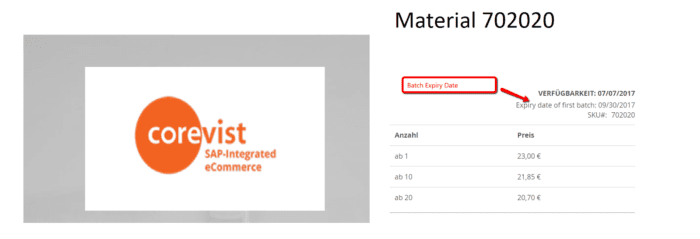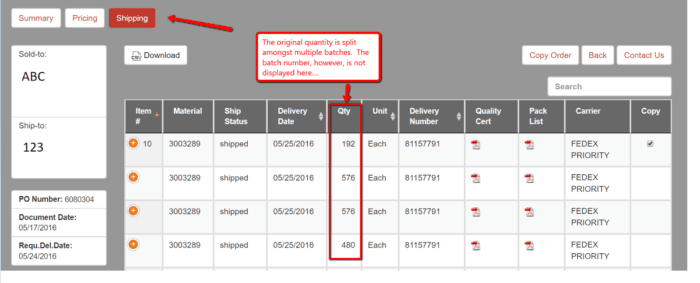Share
Author
Damian Dellavecchia
Share
UPDATE 9/18/19: SAP Inventory Management – The Ultimate Guide for a popular deep dive into topics related to SAP batch management.
SAP Batch Management Best Practices
In the world of B2B selling, SAP batch management can make or break the delivery of product. Pharmaceuticals, biotech, and the food industry generally know this by the terminology “inventory batch number.” In nonperishable industries, we often hear it called “lot number.” Either way, it’s the same idea, and it depends on the same underlying technology in SAP—setting up inventory management using batch numbers.
But now you’re thinking about adding an SAP B2B eCommerce channel. You want the increased efficiency, order accuracy, and customer satisfaction that can come from this new channel. Okay… how should the eCommerce solution handle inventory batch management?
Companies need to define and clarify their SAP batch management process. That’s step 1. Step 2—figure out what batch information you want to display (or not display) in the eCommerce store. Whatever companies already do to manage batch, the eCommerce store can absolutely support that process.
But how much inventory batch information should you give your customers? Here are the Four Inventory Batch Models that we typically see in the SAP eCommerce market.
SAP batch management model #1: Display baseline information
In some industries, batch expiration data can make or break an order. In that case, you have to give the customer some kind of data so they know what to expect. We often see this, where a company will display a “minimum expiration date” that the customer can expect on the order. In other words, the intelligent eCommerce store reads SAP batch expiration data, in real time. The store then displays a promise that the order will not include any product that expires sooner than a certain date. That date is taken directly from SAP data, but the full data of all expiration dates is not available to the customer.
This model gives the customer visibility into what’s coming (and when it expires), but it doesn’t give the customer any flexibility to choose between multiple batches. It falls about midway on the spectrum, somewhere between “no batch data displayed” and “give the customer full batch visibility and control.”
SAP batch management model #2: Display baseline information and allow manual batch requests
Here’s another scenario. You say to the customer, “I’ll give you the opportunity to request something specific. I won’t tell you all the batches in the system, but you tell me what colors you want, what basic manufacturing date range you want to buy from, etc. I’ll match that up to SAP data.”
We’re doing this today. One of our clients has a text box where the customer can request a specific color, inventory manufacture date, and so on. This is to ensure that colors in textiles or carpeting match up exactly. The batch doesn’t get assigned until the order fulfillment process. It creates a workflow in SAP, and it requires a CSR to get involved and service the request.

Item Text Box Example.
This feature allows the customer to make a request, but it doesn’t allow the customer to actually specify what inventory batch they want to buy from. There’s no dropdown box of options. The customer has to type the request into a text box, and the CSR is instructed to honor the request if possible.
SAP batch management model #3: Offer full transparency and customer choice
At the far end of the spectrum, you can offer your customers total transparency on inventory batches. When they go to select a product, you can show them all the batches that are in inventory.
Obviously, this isn’t a good strategy when batch numbers are tied to expiration dates. You need to move the oldest inventory first, but the customer wants the newest inventory. This isn’t really a viable business case in pharma, biotech, and similar industries.
However, in industries with non-expiring products, full batch visibility can be a great value-add for customers. In those types of industries, the terminology is usually “lot number” rather than “batch number.”
Maybe your customer wants to reorder more floor tiles that were produced within a certain date range. They want tiles from the same lot number. That way, they can get the same exact color and texture as they got in their initial order. Floor tiles don’t go bad, so there’s nothing to lose by showing lot numbers in the eCommerce store.
SAP batch management model #4: Don’t display any information
Some companies don’t need (or want) to give customers inventory batch information, whether through CSRs or through eCommerce. We often see this when inventory batch numbers don’t affect the client’s customers in any way, or when inventory batch numbers are tied to product expiration dates. In these cases, inventory management may be set to use batch numbers in SAP, but this is strictly for internal purposes.
You can handle this easily in eCommerce. Just leave out batch data. If your customers don’t need to know it now, when you’re taking orders via phone/fax/email, they don’t need to know it in the self-service eCommerce store.
The good news is—if this need changes in the future, we can always modify the eCommerce store to display batch data. We can carry any type of existing SAP data into the web portal.
Can you really manage SAP batches through the web portal?
Yes. Absolutely.
We can put any SAP data to work for your customers in a self-service web environment.
First off, you need to identify these objects in SAP and classify your master data accordingly. Those objects enable track and trace.
Once these objects are established in SAP, our eTrack module carries them to the web portal for tracking. This is how we enable inventory batch display in the eCommerce store. All tracking queries interrogate SAP data directly, so there is no data duplication involved. It’s the most efficient way to track inventory batches and display them in an eCommerce environment.
We can also display inventory batch information in the catalog (whether eCatalog or Magento), and in our eCart application.

Batch data as displayed in the catalog.

Batch data as displayed in the cart.
What about tracking batch splits?
Yep—we can do that, too.
We encounter this need a lot. A client wants to display batch splits in the eCommerce store. For example, one material, requested quantity of 100, could be split into 2 batches of 50 and 50. We can carry any inventory batch data to the web portal.

Batch data displayed in eTrack.
Of course, not every company needs to communicate batch splits to their customers. But for companies that need this type of functionality, it’s totally doable in our eTrack module.
How does this impact an eCommerce website?
Basically, the eCommerce site can show (or hide) whatever inventory batch data you want.
If you choose to show any inventory batch data, we can provide (or withhold) any type of customer self-service control.
In other words, your SAP B2B eCommerce site should be a “window over top” of your SAP, bringing the appropriate data to the web in a form that is easily for customers to work with.
What the eCommerce site cannot do is answer the question of inventory batch data for you. Rather, you need to solidify your business processes around this data and determine how you want customers to interact with it (or not). Then you can craft an eCommerce solution that supports those business processes.
The Takeaway
Handling inventory batch data in eCommerce doesn’t have to be hard. If you want to talk about the pros and cons of different business processes for SAP batch management, or if you want to examine how those processes can become a value-add in an eCommerce environment, don’t hesitate to get in touch. I’d love to hear from you.
Image courtesy of Army Medicine USAPHC TOX Lab. Licensed under Creative Commons 2.0.
[want_more title=”Want more SAP expertise?” subtitle=”Learn about SAP inventory management” description=”SAP inventory management doesn’t have to be complicated. Our in-depth guide will give you the tools you need.” button_text=”Learn More” button_link=”https://www.corevist.com/sap-inventory-management/” button_class=”test” title2=”See if for yourself” subtitle2=”Talk to us” description2=”Curious what the Corevist Platform can do for you? Let us show you a personalized demo. You’ll see ecommerce with real-time SAP data.” button_text2=”Schedule Demo” button_link2=”https://www.corevist.com/demo/” button_class2=”demo-popup”]








